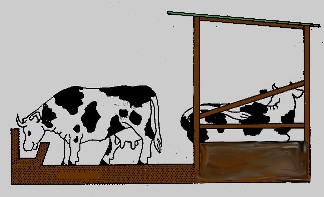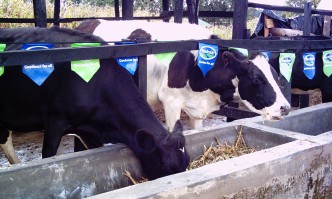Many livestock farmers have raised enquiries about the best practices for a profitable zero grazing enterprise. Before dwelling on to this topic, livestock farmers should understand that a modern zero grazing unit is not zero feeding.
Many farmers have incurred enormous costs in setting up zero grazing enterprises but have ended up failing miserably. Influential leaders have not been spared either. And all this is due to a lack of understanding of the pertinent requirements for a profitable zero grazing enterprise.
A modern zero grazing unit or stall feeding is basically confining dairy cattle in a stall and feeding them there. There is minimum movement of cattle because they are not allowed to graze in the fields and thus the term zero grazing. Many smallholder dairy farmers in Kenya are embracing the zero grazing model of dairy production because of the many benefits accruing from it. Problems such as shortage of grazing land, low productivity of dairy cows, low quality fodder, prevalence of diseases and lack of money are dealt with in this system of dairy production.
The zero-grazing unit

Cows are kept and fed inside the stall all year. The site where the unit is built determines the efficiency of operations throughout the modern zero grazing unit. It should be near as possible to the source of forage to reduce labor costs of carrying the cut grass to the cows and carrying manure back to the farm. Zero grazing requires an increased level of labor input, due to the need to cut grass daily. The time requirement is about 3 man hours/cow/day. Proximity to the homestead in relation to the biogas plant is also an important consideration.
The quality and quantity of construction material should be assessed thoroughly to determine the least possible cost while maintaining quality of the house. Quality materials which are locally available can greatly reduce costs. The cow shed must be functional, cheap and long lasting. The choice of an artisan is important because a lot of expensive material can be wasted by hiring a bad artisan. Note that the most expensively built stable is not always the best and most economical one.
Farmers are advised to use recommended zero grazing housing plans.
Improved dairy cattle breeds
In order to increase milk production you need to concentrate on fewer, better fed and better quality animals. Stock the units with dairy cows that have been bred specifically for their high milk yield. Important dairy breeds of cattle in Kenya for high-milk yield are Jersey, Ayrshire, Guernsey, Friesian and Sahiwal.
Maintain the dairy breeds by upgrading your stock through artificial insemination using proven dairy-bull semen. Selecting good cows and culling non performing ones coupled with good calf rearing for replacement stock should be an integral part of the system.
Adequate forage resource base
Grassland management and flexibility are the keys to the effectiveness of this system. Planning ahead is critical to ensure there is always adequate forage available for the animals. A modern zero grazing unit can provide opportunities for herd expansion by increased forage utilization or through accessing land beyond cow walking distance for grazing.
Think commercially and know the maximum forage production potential of your farm holding and the potential amount of off farm forage available to your herd in a given year. This will enable you to determine the maximum number of animals your zero grazing enterprise can support. The amount of forage, whether obtained within or outside the farm, is actually the single most resource that determines the number of cows or animals that can be sustained in the unit because.
- In feeding the cows the forage to concentrate ratio cannot surpass 60:40 percent. A ratio of 70:30 is recommended.
- Forages take time to establish as opposed to concentrates which can be purchased on demand.
Elephant (nappier) grass (penisetum puperum) grass is preferred as the main fodder crop because it has the advantage of being relatively easy to grow and re-grows rapidly after cutting. Other useful crops or grasses are fodder maize and fodder sorghum. Choose the most suitable fodder to your locality.
Replenish soil fertility by recycling all manure on the napier crop every 2 to 3 days. Apply 4 bags (@ 50 kg) of compound NPK fertilizer (20-10-10) per acre per year. This should also apply when establishing other kind of fodder. Harvest the mature napier grass after it has grown to 60-90cm in height. The aim should always be to produce the highest amount of dry matter (DM) per unit area of fodder grown.
Plant 0.75 – 1 acre of napier grass per mature cow and her offspring. A daily intake of 75-100kg of fresh grass/cow can be achieved with good management to give a dry matter intake of 14-16kg/day. A fresh weight intake of 100kg/cow/day would be required for 15kg DM of grass.
With a modern zero grazing unit, you need to become skilled at producing and conserving feed for the dry season to ensure that milk production is maintained at a steady rate throughout the year. One of the greatest problems is providing good quality feed to the herd during the dry season. Dig a silage pit to store and preserve animal feed. Learn to store grass for use during the dry season by making your own Silage and Hay. The increased utilization of off farm fodder can allow for an increase of stocking rate on the farm. You can buy or rent more land for animal feed or purchase feed from neighbors.
Feeding
Cows fed to capacity on grasses alone have the potential to produce up to a maximum of 7 Kg of milk per day. Additional milk is supported by concentrates. Keep in mind that it is pointless to feed supplements when forage requirements are not met.
of milk per day. Additional milk is supported by concentrates. Keep in mind that it is pointless to feed supplements when forage requirements are not met.
Give concentrate supplement as the main source of energy and protein. Most farmers prefer giving dairy meal to the cows at milking time. Supplement at a rate of 1 kg for each 1.5 litres of milk the cow produces on top of the 7 Kg of milk contributed by grass. Other concentrates like sunflower seed cake, cotton seed cake and bran are available. For example farmers say that the use of brewer’s waste as a feeding supplement, ad lib, increases milk production by 7 litres per day.
Fodder legumes constitute an additional source of protein. Fodder trees such as Leucaena spp., Calliandra spp, and Sesbania spp, are used to increase the protein content of the herd’s diet.
But the most important thing is to have your ration formula right. Ration formulation is a complex process and any farmer cannot just do it. You will need the skills of a qualified professional to come up with the right mixture of the feeds available to your cows. Invest in a chaff-cutter to mill crop residues for feed so that nothing goes to waste. Cows must have adequate feeding space, and wastage must be monitored, to ensure feed intake is maximized. Wastage should be less than 5%, and refused material must be removed from the feeding area daily, as this will decompose rapidly.
Innovative livestock farmers have come up with home-mix dairy rations. An example composition of a 100 kg of home-mix dairy ration is 40 kg sunflower cake, 40 kg maize grain, 10 kg sorghum, 5 kg soya beans and 5 kg dried cassava chips. The mixture is dried and milled. Farmers who use this home-mix state that they get twice as much milk from their home mix as they do for the same amount of purchased commercial dairy meal
Mineral salt lick should be offered to the cattle ad lib in the mineral box. Water should be available throughout the day as it makes the bulk of the milk.
Stable manure production
Manure should be treated carefully to reap maximum benefit from it. Manure contain high content of organic matter and minerals which improve soil fertility therefore forage yields and is source of material for biogas production. Cover the manure pit to prevent nitrogen losses.
One cow can produce up to 20 tons of compost per year depending on availability of crop residues. 20 tons of compost contains approximately 80 kg of nitrogen, 40 kg of phosphate and 10 kg of potash. If valued against current fertilizer prices this composition is valued at Kshs. 2000.
The manure produced from 3 cows is sufficient to produce the amount of gas needed for cooking and lighting in the farm.
Did you love the story? You can also share YOUR story and get it published on Bizna Click here to get started.




